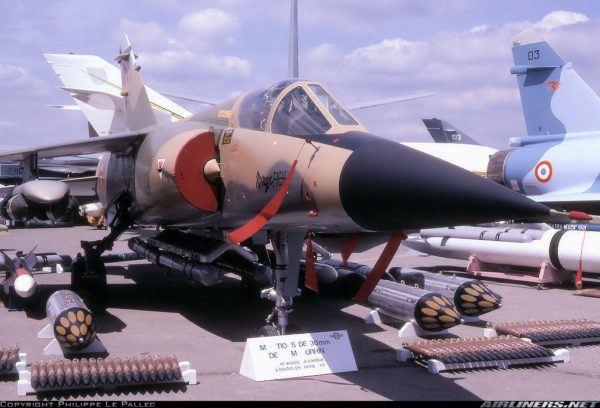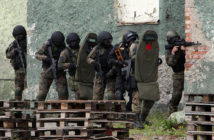ResearchAndMarkets.com
The “Future of the Moroccan Defense Industry – Market Attractiveness, Competitive Landscape and Forecasts to 2024” report has been added to ResearchAndMarkets.com’s offering.
This report provides readers with detailed analysis of both historic and forecast defense industry values, factors influencing demand, the challenges faced by industry participants, analysis of industry leading companies, and key news.
- Between 2015 and 2019, Morocco’s defense expenditure increased from US$3.3 billion in 2015 to US$3.7 billion in 2019, registering a CAGR of 3.39%.
- The defense budget is anticipated to increase from US$3.9 billion in 2020 to US$4.7 billion by 2024, registering a CAGR of 4.24%.
- The rise in defense spending is mainly driven by the procurement of F-16 Fighting Falcons, Single Channel Ground and Airborne Radio Systems (SINCGARS) combat net radio, M1A1 tanks, electric submarines and patrol ships.
The prime factor stimulating the country’s defense expenditure is its ongoing arms race with adjoining Algeria, which receives a steady supply of weapons from Russia.
Over the forecast period, the increased threat of terrorism from internal and external terrorist groups and the ongoing modernization of its armed forces are the key factors expected to drive military expenditure. The country also faces insurgency in the Western Sahara region, where the local insurgent outfit Polisario Front is engaged in a violent struggle with the Moroccan regime for territory. The threat posed by the prospect of prolonged insurgency within the Western Sahara region makes it imperative for Morocco to allocate substantial expenditure to counter-terrorism and counter-insurgency efforts.
Morocco is projected to increase its defense budget from US$3.7 billion in 2019 to US$4.7 billion in 2024, at a CAGR of 4.24%. Moroccan homeland security (HLS) expenditure increased from US$2.1 billion in 2015 to US$3 billion in 2019, registering a CAGR of 8.56%. On a cumulative basis, Morocco is expected to spend a total of US$21.4 billion on its armed forces over the forecast period, compared to US$17.5 billion over 2015-2019. The country’s capital expenditure is expected to increase from US$1.2 billion in 2020 to US$1.4 billion in 2024, growing at a robust CAGR of 4.31% over the forecast period.
The Moroccan government is expected to procure transport aircraft, multirole fighters, submarines, missile defense system, and armored vehicles, among others. Additionally, opportunities in security systems and platforms such as military IT networking, wireless systems, motion sensors, alarms, and radar systems are expected to arise as a result of the country’s focus on strengthening border security.
1. Introduction
2. Executive Summary
3. Market Attractiveness and Emerging Opportunities
3.1. Current Market Scenario
3.1.1. Primary threat perception
3.1.2. Military Doctrine and Strategy
3.1.3. Equipment of Moroccan Military
3.1.4. Procurement Programs
3.1.5. Social, Political and Economic Environment and Support for Defense Projects
3.1.6. Political and Strategic Alliances
3.2. Defense Market Size Historical and Forecast
3.2.1. Moroccan Defense Budget is Expected to Register a CAGR of 4.24% over the Forecast Period
3.2.2. Counter-terrorism, Border Security, and the Need to Modernize Outdated Defense Equipment Are Expected to Drive Morocco’s Defense Expenditure
3.2.3. Defense expenditure as a percentage of GDP is expected to average 3% over the forecast period
3.3. Analysis of Defense Budget Allocation
3.3.1. Capital Expenditure Share Expected to Increase Marginally over the Forecast Period
3.3.2. Capital Expenditure Anticipated to Grow at a CAGR of 4.31% over the Forecast Period
3.3.3. Per Capita Defense Expenditure Expected to Increase During the Forecast Period
3.4. Homeland Security Market Size and Forecast
3.4.1. Moroccan Homeland Security Expenditure Anticipated to Increase at a CAGR of 7.87%
3.4.2. Human Trafficking, Drug Smuggling and Cybercrime Are the Major Targets of Homeland Security Expenditure
3.5. Benchmarking with Key Global Markets
3.5.1. Morocco is the Fourth Largest Defense Spender in the North African Region
3.5.2. Morocco’s Military Expenditure is Low when Compared to the Largest Defense Spenders but on Par with Other African Countries
3.5.3. Morocco Allocates a Moderate Percentage of its GDP to Defense
3.6. Market Opportunities: Key Trends
3.6.1. Top 10 Defense Market Sectors by Value (US$ Million), 2019-2024
3.6.2. Critical Infrastructure Protection – Physical Security
3.6.3. Naval Vessel MRO – Corvettes
3.6.4. Land-Based C4ISR
4. Defense Procurement Market Dynamics
4.1. Import Market Dynamics
4.1.1. Defense Imports to be Driven by Modernization Initiatives over the Forecast Period
4.1.2. Morocco Imports the Majority of its Arms from Europe
4.1.3. Armored Vehicles Accounted for the Majority of Defense Imports during 2013-2017
4.2. Export Market Dynamics
4.2.1. Morocco Does not Export Arms due to its Under-Developed Domestic Arms Industry
5. Industry Dynamics
6. Market Entry Strategy
6.1. Market Regulation
6.1.1. Morocco does not disclose any offset obligations imposed by the country
6.1.2. Foreign direct investment (FDI) is determined on a case-by-case basis
6.2. Market Entry Route
6.2.1. Budgeting Process
6.2.2. Procurement Policy and Process
6.2.3. Government-to-government agreements are the preferred market entry route for foreign OEMs
6.2.4. Joint venture and license manufacturing agreements provide an attractive market entry route
6.2.5. Key Challenges
7. Competitive Landscape and Strategic Insights
7.1. Competitive Landscape Overview
7.1.1. Morocco Market Share Analysis, 2018-2023
7.2. Key Foreign Companies
7.2.1. Lockheed Martin Corp.: Overview
7.2.2. Lockheed Martin Corp.: Products and Services
7.2.3. Lockheed Martin Corp.: Recent Announcements and Strategic Initiatives
7.2.4. Lockheed Martin Corp.: Recent Contract Wins
7.2.5. Raytheon: Overview
7.2.6. Raytheon: Products and Services
7.2.7. Raytheon: Recent Announcements and Strategic Initiatives
7.2.8. Raytheon: Recent Contract Wins
7.2.9. Damen Schelde Naval Shipbuilding: Overview
7.2.10. Damen Schelde Naval Shipbuilding: Products and Services
7.2.11. Damen Schelde Naval Shipbuilding: Recent Announcements and Strategic Initiatives
7.2.12. Damen Schelde Naval Shipbuilding: Recent Contract Wins
8. Business Environment and Country Risk
8.1. Economic Performance
8.1.1. GDP Per Capita
8.1.2. GDP, Current Prices
8.1.3. Exports of Goods and Services (Current LCU Billion)
8.1.4. Imports of Goods and Services (Current LCU Billion)
8.1.5. Gross National Disposable Income (US$ Billion)
8.1.6. Local Currency Unit per US Dollar
8.1.7. Market Capitalization of Listed Companies (US$ Billion)
8.1.8. Market Capitalization of Listed Companies (% of GDP)
8.1.9. Government Cash Surplus/Deficit as a Percentage of GDP (LCU)
8.1.10. Goods Exports as a Percentage of GDP
8.1.11. Goods Imports as a Percentage of GDP
8.1.12. Services Imports as a Percentage of GDP
8.1.13. Service Exports as a Percentage of GDP
8.1.14. Foreign Direct Investment, Net (BoP, Current US$ Billion)
8.1.15. Net Foreign Direct Investment as Percentage of GDP
8.1.16. Mining, Manufacturing, Utilities Output LCU Billion
For more information about this report visit https://www.researchandmarkets.com/r/2ubrl0
View source version on businesswire.com:https://www.businesswire.com/news/home/20190520005568/en/
CONTACT: ResearchAndMarkets.com
Laura Wood, Senior Press Manager
press@researchandmarkets.com
For E.S.T Office Hours Call 1-917-300-0470
For U.S./CAN Toll Free Call 1-800-526-8630
For GMT Office Hours Call +353-1-416-8900
Related Topics:Military Aerospace and Defense
KEYWORD: MOROCCO AFRICA
INDUSTRY KEYWORD: DEFENSE OTHER DEFENSE
SOURCE: Research and Markets
Copyright Business Wire 2019.
PUB: 05/20/2019 11:38 AM/DISC: 05/20/2019 11:38 AM
http://www.businesswire.com/news/home/20190520005568/en







